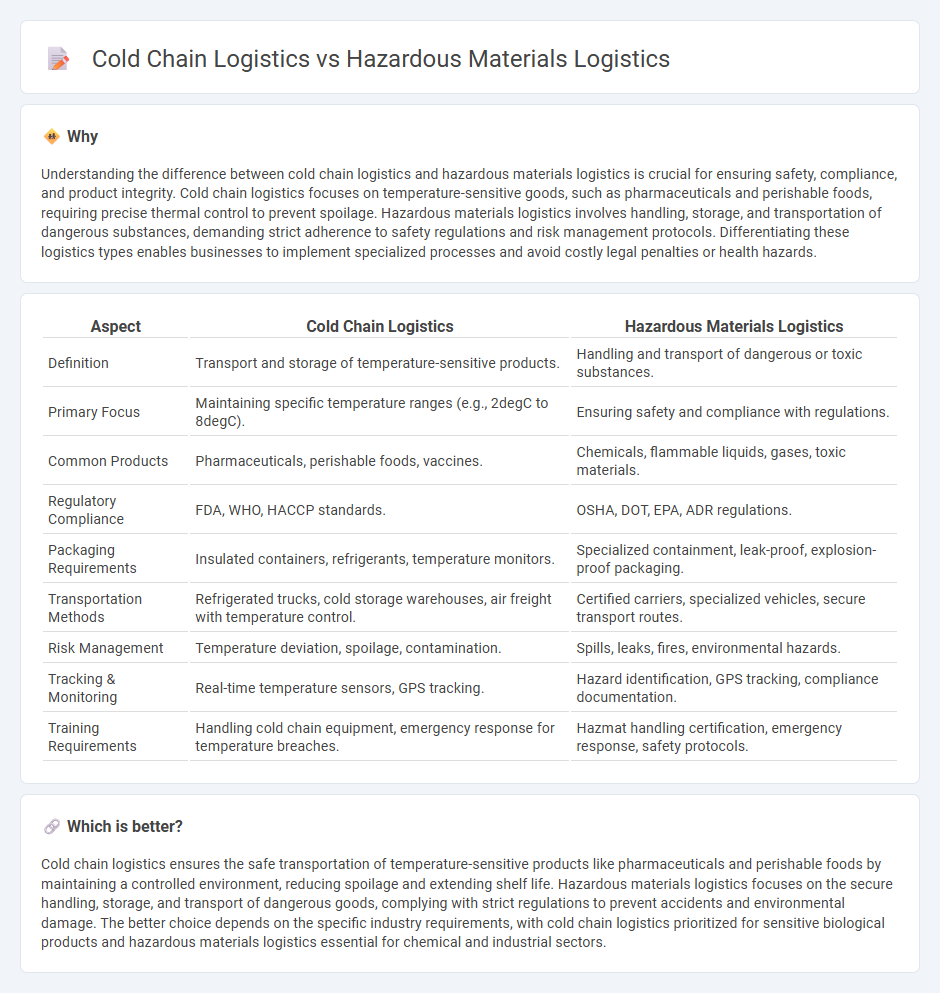
Cold chain logistics ensures temperature-sensitive products like pharmaceuticals and perishable foods maintain optimal conditions through refrigerated transport and storage. Hazardous materials logistics involves specialized handling, packaging, and compliance with regulations to safely transport flammable, toxic, or corrosive substances. Explore the critical differences and best practices in these vital logistics sectors for enhanced supply chain management.
Why it is important
Understanding the difference between cold chain logistics and hazardous materials logistics is crucial for ensuring safety, compliance, and product integrity. Cold chain logistics focuses on temperature-sensitive goods, such as pharmaceuticals and perishable foods, requiring precise thermal control to prevent spoilage. Hazardous materials logistics involves handling, storage, and transportation of dangerous substances, demanding strict adherence to safety regulations and risk management protocols. Differentiating these logistics types enables businesses to implement specialized processes and avoid costly legal penalties or health hazards.
Comparison Table
| Aspect | Cold Chain Logistics | Hazardous Materials Logistics |
|---|---|---|
| Definition | Transport and storage of temperature-sensitive products. | Handling and transport of dangerous or toxic substances. |
| Primary Focus | Maintaining specific temperature ranges (e.g., 2degC to 8degC). | Ensuring safety and compliance with regulations. |
| Common Products | Pharmaceuticals, perishable foods, vaccines. | Chemicals, flammable liquids, gases, toxic materials. |
| Regulatory Compliance | FDA, WHO, HACCP standards. | OSHA, DOT, EPA, ADR regulations. |
| Packaging Requirements | Insulated containers, refrigerants, temperature monitors. | Specialized containment, leak-proof, explosion-proof packaging. |
| Transportation Methods | Refrigerated trucks, cold storage warehouses, air freight with temperature control. | Certified carriers, specialized vehicles, secure transport routes. |
| Risk Management | Temperature deviation, spoilage, contamination. | Spills, leaks, fires, environmental hazards. |
| Tracking & Monitoring | Real-time temperature sensors, GPS tracking. | Hazard identification, GPS tracking, compliance documentation. |
| Training Requirements | Handling cold chain equipment, emergency response for temperature breaches. | Hazmat handling certification, emergency response, safety protocols. |
Which is better?
Cold chain logistics ensures the safe transportation of temperature-sensitive products like pharmaceuticals and perishable foods by maintaining a controlled environment, reducing spoilage and extending shelf life. Hazardous materials logistics focuses on the secure handling, storage, and transport of dangerous goods, complying with strict regulations to prevent accidents and environmental damage. The better choice depends on the specific industry requirements, with cold chain logistics prioritized for sensitive biological products and hazardous materials logistics essential for chemical and industrial sectors.
Connection
Cold chain logistics and hazardous materials logistics intersect through stringent temperature control and safety protocols essential for transporting sensitive goods like pharmaceuticals and chemicals. Both require specialized packaging, monitoring systems, and compliance with regulatory standards such as the FDA and OSHA to prevent contamination or accidents. Integration of these logistics ensures the stability of temperature-sensitive hazardous materials, minimizing risk throughout the supply chain.
Key Terms
**Hazardous Materials Logistics:**
Hazardous materials logistics involves the specialized handling, storage, and transportation of substances that pose risks to health, safety, or the environment, such as chemicals, flammable liquids, and radioactive materials. Strict compliance with regulations like OSHA, DOT, and international standards ensures secure packaging, labeling, and emergency response procedures to mitigate potential accidents. Explore further to understand best practices and innovative technologies in hazardous materials logistics management.
Material Safety Data Sheet (MSDS)
Material Safety Data Sheet (MSDS) is critical in hazardous materials logistics to ensure safe handling, storage, and transportation by providing detailed information on chemical properties and associated risks. In cold chain logistics, MSDS helps manage temperature-sensitive materials by outlining specific safety measures and compatibility with refrigeration equipment. Explore further to understand how MSDS integration enhances the safety and efficiency of both logistics sectors.
Dangerous Goods Regulations (DGR)
Hazardous materials logistics centers on the safe handling, packaging, and transportation of dangerous goods in compliance with Dangerous Goods Regulations (DGR) set by organizations like IATA and IMO, ensuring risk minimization and regulatory adherence. Cold chain logistics manages the temperature-controlled supply chain for perishable items, incorporating DGR standards when transporting hazardous biological substances or vaccines that require refrigerated conditions. Explore detailed guidelines and best practices to ensure compliance and safety in both logistics sectors.
Source and External Links
Hazmat Logistics: Handling & Transport of Dangerous Goods - Hazmat logistics encompasses the safe and efficient handling, storing, and transporting of hazardous materials, including compliance with regulations, proper packaging, labeling, and emergency response training to protect people and the environment.
Dangerous Goods and Hazmat Logistic Services - Specialized hazmat logistics providers, such as Life Couriers, offer certified and compliant transport of hazardous materials regulated by agencies like US DOT and PHMSA, with trained personnel and insurance coverage ensuring secure handling and delivery.
10 Common Hazardous Materials (HAZMAT) in Logistics - Common hazardous materials in logistics include flammable liquids, corrosive chemicals, explosives, and radioactive materials, all requiring strict adherence to regulatory safety standards, specialized packaging, and trained personnel for safe transport and handling.
 dowidth.com
dowidth.com